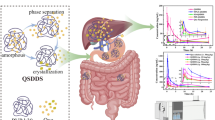Abstract
Due to the fact that the number of new poorly soluble active pharmaceutical ingredients is increasing, it is important to investigate the possibilities of improvement of their solubility in order to obtain a final pharmaceutical formulation with enhanced bioavailability. One of the strategies to increase drug solubility is the inclusion of the APIs in cyclodextrins. The aim of this study was to investigate the possibility of aripiprazole solubility improvement by inclusion in (2-hydroxy)propyl-β-cyclodextrin (HPBCD) and simultaneous manipulation of pH of the medium and addition of polyvinylpyrrolidone. Aripiprazole–HPBCD complexes were prepared by spray drying aqueous drug–HPBCD solutions, and their properties were compared with those prepared by solvent-drop co-grinding and physical mixing. The obtained powders were characterized by thermoanalytical methods (TGA and DSC), FTIR spectroscopy, their dissolution properties were assessed, while the binding of aripiprazole into the cavity of HPBCD was studied by molecular docking simulations. The solubilization capacity was found to be dependent on pH as well as the buffer solution’s ionic composition. The presence of PVP in the formulation could affect the solubilization capacity significantly, but further experimentation is required before its effect is fully understood. On the basis of solubility studies, the drug/HPBCD stoichiometry was found to be 1:3. The spray-dried products were free of crystalline aripiprazole, they possessed higher solubility and dissolution rate, and were stable enough over a prolonged period of storage. Spray drying of cyclodextrin solutions proved to be an appropriate and efficient technique for the preparation of highly soluble inclusion compounds of aripiprazole and HPBCD.








Similar content being viewed by others
REFERENCES
Dubin CH. Formulation strategies for poorly soluble drugs. Drug Del Technol. 2006;6(6):34–8.
Challa R, Ahuja A, Ali J, Khar RK. Cyclodextrins in drug delivery: an updated review. AAPS Pharm Sci Tech. 2005;6(2):E329–57. Article 43.
Brewster ME, Loftsson T. Cyclodextrins as pharmaceutical solubilizers. Adv Drug Del Rev. 2007;59:645–66.
Szejtli J. Past, present, and future of cyclodextrin research. Pure Appl Chem. 2004;76(10):1825–45.
Vyas A, Saraf S, Saraf S. Cyclodextrin based novel drug delivery systems. J Incl Phenom Macrocycl Chem. 2008;62:23–42.
Redenti E, Szente L, Szejtli J. Mini-review drug/cyclodextrin/hydroxy acid multicomponent systems, properties and pharmaceutical applications. J Pharm Sci. 2000;89(1):1–8.
Trott O, Olson AJ. AutoDock Vina: improving the speed and accuracy of docking with a new scoring function, efficient optimization and multithreading. J Comput Chem. 2010;31:455–61.
Momany FA, Rone R. Validation of the general purpose QUANTA ®3.2/CHARMm® force field. J Comput Chem. 1992;13:888–900.
Pedretti A, Villa L, Vistoli G. VEGA: a versatile program to convert, handle and visualize molecular structure on Windows-based PCs. J Mol Graph. 2002;21:47–9.
Phillips J, Braun R, Wang W, Gumbart J, Tajkhorshid E, Villa E, et al. Scalable molecular dynamics with NAMD. J Comput Chem. 2005;26:1781–802.
Gramera RE, Caimi RJ. Cyclodextrin polyethers and their production. US Patent 3,459,731. August 5, 1969.
Morris GM, Goodsell DS, Halliday RS, Huey R, Hart WE, Belew RK, et al. Automated docking using a Lamarckian genetic algorithm and an empirical binding free energy function. J Comput Chem. 1998;19:1639–62.
Braun DE, Gelbrich T, Kahlenberg V, Tessadri R, Wieser J, Griesser UJ. Conformational polymorphism in aripiprazole: preparation, stability and structure of five modifications. J Pharm Sci. 2009;98:2010–26.
Mura P, Faucci MT, Bettinetti GP. The influence of polyvinylpyrrolidone on naproxen complexation with hydroxypropyl β-cyclodextrin. Eur J Pharm Sci. 2001;13:187–94.
Raghavan SL, Trividic A, Davis AF, Hadgraft J. Crystallization of hydrocortisone acetate: influence of polymers. Int J Pharm. 2001;212:213–21.
Li P, Tabibi SE, Yalkowski SH. Combined effect of complexation and pH on solubilization. J Pharm Sci. 1998;87(12):1535–7.
Buchanan CM, Buchanan NL, Edgar KJ, Ramsey MG. Solubility and dissolution studies of antifungal drug:hydroxybutenyl-β-cyclodextrin complexes. Cellulose. 2007;14:35–47.
Quan P, Liu DF, Li R, Zhang Q, Qian Y, Xu QW. The effects of water-soluble polymers on hydroxypropyl-β-cyclodextrin solubilization of oleanolic acid and ursolic acid. J Incl Phenom Macrocycl Chem. 2009;63:181–8.
Loftsson T, Hreinsdottir D, Masson M. Evaluation of cyclodextrin solubilization of drugs. Int J Pharm. 2005;302:18–28.
Messner M, Kurkov SV, Jansook P, Loftsson T. Self-assembled cyclodextrin aggregates and nanoparticles, review article. Int J Pharm. 2010;387(1–2):199–208.
Nacsa A, Berkesi O, Szabo-Revesz P, Aigner Z. Achievement of pH-independence of poorly-soluble, ionizable loratadine by inclusion complex formation with dimethyl-β-cyclodextrin. J Incl Phenom Macrocycl Chem. 2009;64:249–54.
ACKNOWLEDGMENTS
This work was supported by the Project TR 34007, Ministry of Education and Science, Republic of Serbia.
Author information
Authors and Affiliations
Corresponding author
Rights and permissions
About this article
Cite this article
Mihajlovic, T., Kachrimanis, K., Graovac, A. et al. Improvement of Aripiprazole Solubility by Complexation with (2-Hydroxy)propyl-β-cyclodextrin Using Spray Drying Technique. AAPS PharmSciTech 13, 623–631 (2012). https://doi.org/10.1208/s12249-012-9786-3
Received:
Accepted:
Published:
Issue Date:
DOI: https://doi.org/10.1208/s12249-012-9786-3




